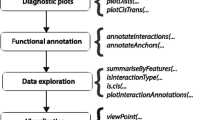Abstract
This chapter describes methods currently available for visualizing results from systems genetics experiments. Here, we abstract from the statistical methods used for genetic mapping, which are dependent on the specific resource being used, i.e. F2, RILs, or outbred populations among others. We use a public dataset with results from a mouse eQTL experiment for three examples of visualization: genome-wide dot plots of marker-by-gene association, karyotype-like plots, and circos plots. Dot plots give a first overview of the results from eQTL mapping, allowing detecting genome-wide patterns of cis- and trans-genetic association to transcription level. Karyotype-like plots provide chromosomal context and allow integrating multiple tracks of information in a single plot. Circos plots can, in addition, display long-range interactions to provide an overview of genetic connectivity at the genome level. All examples are developed and explained using R code, an open-source language with powerful statistical and graphical capabilities. The principles reviewed here, however, can be applied with other software options, organisms, and to any type of molecular phenotype that can be assigned to a genomic position.
Access this chapter
Tax calculation will be finalised at checkout
Purchases are for personal use only
Similar content being viewed by others
References
Jansen RC, Nap JP (2001) Genetical genomics: the added value from segregation. Trends Genet 17(7):388–391
Civelek M, Lusis AJ (2014) Systems genetics approaches to understand complex traits. Nat Rev Genet 15(1):34–48. doi:10.1038/nrg3575
Jansen RC, Tesson BM, Fu J, Yang Y, McIntyre LM (2009) Defining gene and QTL networks. Curr Opin Plant Biol 12(2):241–246. doi:10.1016/j.pbi.2009.01.003
Schadt EE, Lamb J, Yang X, Zhu J, Edwards S, Guhathakurta D, Sieberts SK, Monks S, Reitman M, Zhang C, Lum PY, Leonardson A, Thieringer R, Metzger JM, Yang L, Castle J, Zhu H, Kash SF, Drake TA, Sachs A, Lusis AJ (2005) An integrative genomics approach to infer causal associations between gene expression and disease. Nat Genet 37(7):710–717. doi:10.1038/ng1589
Turner LM, Harr B (2014) Genome-wide mapping in a house mouse hybrid zone reveals hybrid sterility loci and Dobzhansky-Muller interactions. eLife Sci 3:e02504. doi:10.7554/eLife.02504
Ihaka R, Gentleman R (1996) R: a language for data analysis and graphics. J Comput Graph Stat 5:299–314
Gatti DM, Zhao N, Chesler EJ, Bradford BU, Shabalin AA, Yordanova R, Lu L, Rusyn I (2010) Sex-specific gene expression in the BXD mouse liver. Physiol Genomics 42:456–468. doi:10.1152/physiolgenomics.00110.2009
Verdugo RA, Farber CR, Warden CH, Medrano JF (2010) Serious limitations of the QTL/microarray approach for QTL gene discovery. BMC Biol 8:96. doi:10.1186/1741-7007-8-96
Dzur-Gejdosova M, Simecek P, Gregorova S, Bhattacharyya T, Forejt J (2012) Dissecting the genetic architecture of F1 hybrid sterility in house mice. Evolution 66(11):3321–3335. doi:10.1111/j.1558-5646.2012.01684.x
White MA, Steffy B, Wiltshire T, Payseur BA (2011) Genetic dissection of a key reproductive barrier between nascent species of house mice. Genetics 189(1):289–U988. doi:10.1534/genetics.111.129171
Thorvaldsdottir H, Robinson JT, Mesirov JP (2013) Integrative Genomics Viewer (IGV): high-performance genomics data visualization and exploration. Brief Bioinform 14(2):178–192. doi:10.1093/bib/bbs017
Acknowledgments
We acknowledge Dr. Bettina Harr at the Max-Planck-Institut fuer Evolutionsbiologie for making data available for this publication and for useful communications with the authors that helped improving the manuscript of this chapter. Development of the chromPlot package was funded by Grant FONDECYT 11121666.
Author information
Authors and Affiliations
Corresponding author
Editor information
Editors and Affiliations
1 Electronic Supplementary Materials
Rights and permissions
Copyright information
© 2017 Springer Science+Business Media New York
About this protocol
Cite this protocol
Oróstica, K.Y., Verdugo, R.A. (2017). Visualization of Results from Systems Genetics Studies in Chromosomal Context. In: Schughart, K., Williams, R. (eds) Systems Genetics. Methods in Molecular Biology, vol 1488. Humana Press, New York, NY. https://doi.org/10.1007/978-1-4939-6427-7_13
Download citation
DOI: https://doi.org/10.1007/978-1-4939-6427-7_13
Published:
Publisher Name: Humana Press, New York, NY
Print ISBN: 978-1-4939-6425-3
Online ISBN: 978-1-4939-6427-7
eBook Packages: Springer Protocols




